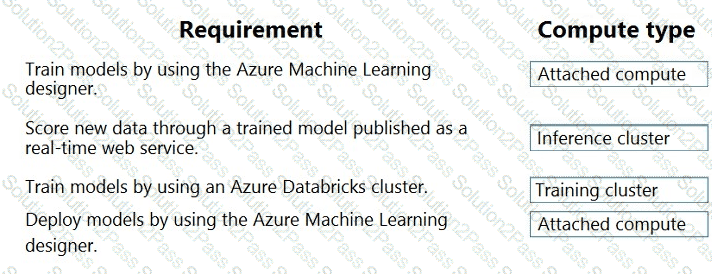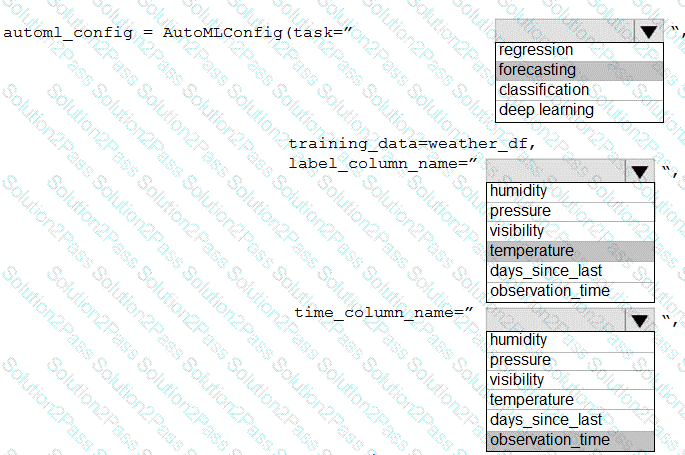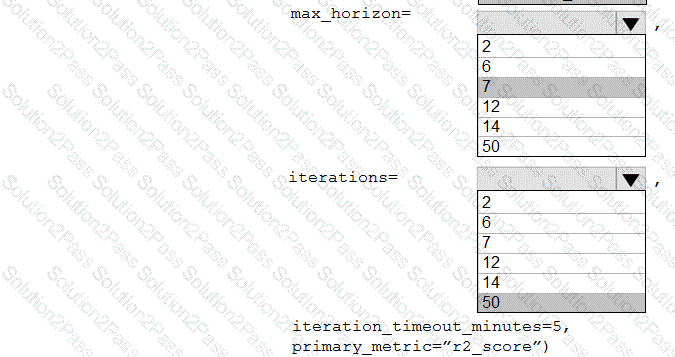DP-100 Microsoft Designing and Implementing a Data Science Solution on Azure Free Practice Exam Questions (2025 Updated)
Prepare effectively for your Microsoft DP-100 Designing and Implementing a Data Science Solution on Azure certification with our extensive collection of free, high-quality practice questions. Each question is designed to mirror the actual exam format and objectives, complete with comprehensive answers and detailed explanations. Our materials are regularly updated for 2025, ensuring you have the most current resources to build confidence and succeed on your first attempt.
You are a data scientist working for a bank and have used Azure ML to train and register a machine learning model that predicts whether a customer is likely to repay a loan.
You want to understand how your model is making selections and must be sure that the model does not violate government regulations such as denying loans based on where an applicant lives.
You need to determine the extent to which each feature in the customer data is influencing predictions.
What should you do?
You define a datastore named ml-data for an Azure Storage blob container. In the container, you have a folder named train that contains a file named data.csv. You plan to use the file to train a model by using the Azure Machine Learning SDK.
You plan to train the model by using the Azure Machine Learning SDK to run an experiment on local compute.
You define a DataReference object by running the following code:

You need to load the training data.
Which code segment should you use?
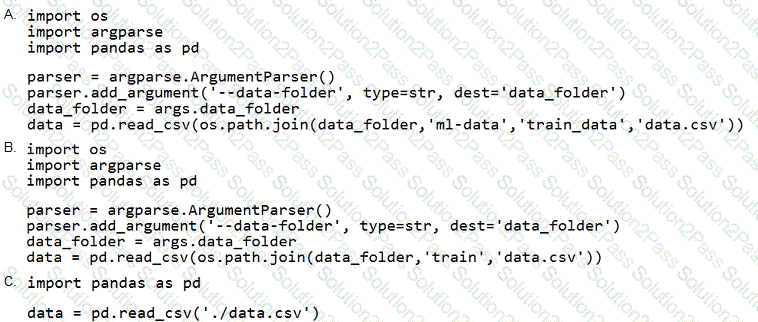
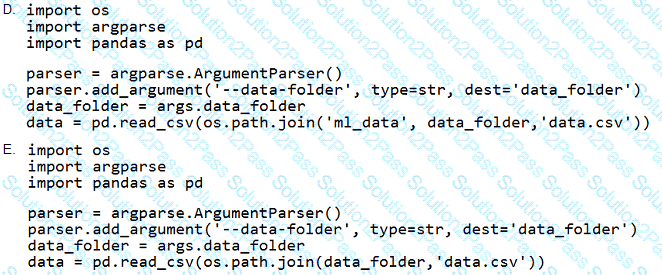
You create a binary classification model. You use the Fairlearn package to assess model fairness. You must eliminate the need to retrain the model. You need to implement the Fair learn package. Which algorithm should you use?
You create machine learning models by using Azure Machine Learning.
You plan to train and score models by using a variety of compute contexts. You also plan to create a new compute resource in Azure Machine Learning studio.
You need to select the appropriate compute types.
Which compute types should you select? To answer, drag the appropriate compute types to the correct requirements. Each compute type may be used once, more than once, or not at all. You may need to drag the split bar between panes or scroll to view content.
NOTE: Each correct selection is worth one point.

You train a model and register it in your Azure Machine Learning workspace. You are ready to deploy the model as a real-time web service.
You deploy the model to an Azure Kubernetes Service (AKS) inference cluster, but the deployment fails because an error occurs when the service runs the entry script that is associated with the model deployment.
You need to debug the error by iteratively modifying the code and reloading the service, without requiring a re-deployment of the service for each code update.
What should you do?
You write five Python scripts that must be processed in the order specified in Exhibit A – which allows the same modules to run in parallel, but will wait for modules with dependencies.
You must create an Azure Machine Learning pipeline using the Python SDK, because you want to script to create the pipeline to be tracked in your version control system. You have created five PythonScriptSteps and have named the variables to match the module names.
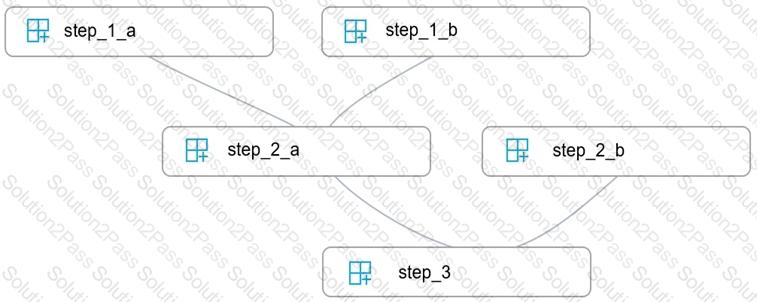
You need to create the pipeline shown. Assume all relevant imports have been done.
Which Python code segment should you use?
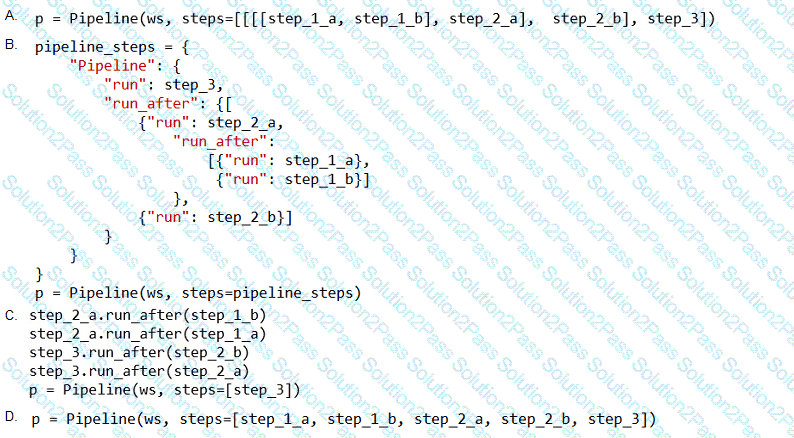
You manage an Azure Machine Learning workspace. You submit a training job with the Azure Machine Learning Python SDK v2. You must use MLflow to log metrics, model parameters, and model artifacts automatically when training a model.
You start by writing the following code segment:

For each of the following statements, select Yes If the statement is true. Otherwise, select No.

Note: This question is part of a series of questions that present the same scenario. Each question in the series contains a unique solution that might meet the stated goals. Some question sets might have more than one correct solution, while others might not have a correct solution.
After you answer a question in this section, you will NOT be able to return to it. As a result, these
questions will not appear in the review screen.
You are creating a model to predict the price of a student’s artwork depending on the following variables: the student’s length of education, degree type, and art form.
You start by creating a linear regression model.
You need to evaluate the linear regression model.
Solution: Use the following metrics: Relative Squared Error, Coefficient of Determination, Accuracy, Precision, Recall, F1 score, and AUC.
Does the solution meet the goal?
You are using the Azure Machine Learning designer to transform a dataset by using an Execute Python Script component and custom code.
You need to define the method signature for the Execute Python Script component and return value type.
What should you define? To answer, select the appropriate options in the answer area.
NOTE: Each correct selection is worth one point.

You use the Azure Machine learning SDK foe Python to create a pipeline that includes the following step:
The output of the step run must be cached and reused on subsequent runs when the source.directory value has not changed.
You need to define the step.
What should you include in the step definition?
You plan to deliver a hands-on workshop to several students. The workshop will focus on creating data
visualizations using Python. Each student will use a device that has internet access.
Student devices are not configured for Python development. Students do not have administrator access to
install software on their devices. Azure subscriptions are not available for students.
You need to ensure that students can run Python-based data visualization code.
Which Azure tool should you use?
You use Azure Machine Learning Designer to load the following datasets into an experiment:
Dataset1

Dataset2

You use Azure Machine Learning Designer to load the following datasets into an experiment:
You need to create a dataset that has the same columns and header row as the input datasets and contains all rows from both input datasets.
Solution: Use the Join Data component.
Does the solution meet the goal?
You use an Azure Machine Learning workspace.
You create the following Python code:

For each of the following statements, select Yes if the statement is true. Otherwise, select No.
NOTE: Each correct selection is worth one point.

You manage an Azure Machine Learning workspace.
You choose the urijolder data type as an output of a pipeline component.
You need to define the data access mode that is supported by your configuration.
Which mode should you define?
: 218 HOTSPOT
You collect data from a nearby weather station. You have a pandas dataframe named weather_df that includes the following data:

The data is collected every 12 hours: noon and midnight.
You plan to use automated machine learning to create a time-series model that predicts temperature over the next seven days. For the initial round of training, you want to train a maximum of 50 different models.
You must use the Azure Machine Learning SDK to run an automated machine learning experiment to train these models.
You need to configure the automated machine learning run.
How should you complete the AutoMLConfig definition? To answer, select the appropriate options in the answer area.
NOTE: Each correct selection is worth one point.
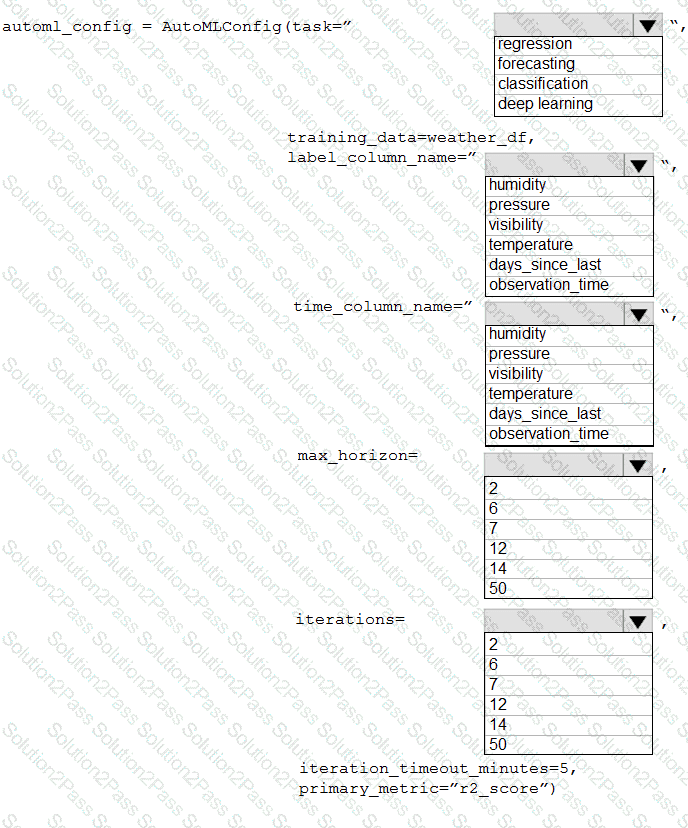
You create a workspace to include a compute instance by using Azure Machine Learning Studio. You are developing a Python SDK v2 notebook in the workspace. You need to use Intellisense in the notebook. What should you do?
You create a workspace by using Azure Machine Learning Studio.
You must run a Python SDK v2 notebook in the workspace by using Azure Machine Learning Studio.
You need to reset the state of the notebook.
Which three actions should you use? Each correct answer presents a complete solution.
NOTE: Each correct selection is worth one point.
You have an Azure AI Foundry project with a connected Azure OpenAI Service model.
You have a set of text files stored locally on your computer.
You must set up a flow that will generate responses based on the content of your local files.
You need to implement a solution.
Which four actions should you perform in sequence? To answer, move the appropriate actions from the list of actions to the answer area and arrange them in the correct order.

You use the Azure Machine Learning designer to create and run a training pipeline. You then create a real-time inference pipeline.
You must deploy the real-time inference pipeline as a web service.
What must you do before you deploy the real-time inference pipeline?
You are developing a machine learning, experiment by using Azure. The following images show the input and output of a machine learning experiment:

Use the drop-down menus to select the answer choice that answers each question based on the information presented in the graphic.
NOTE: Each correct selection is worth one point.


